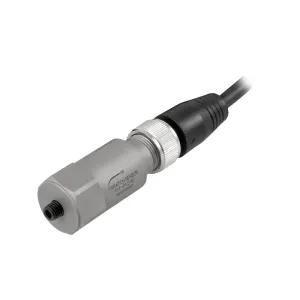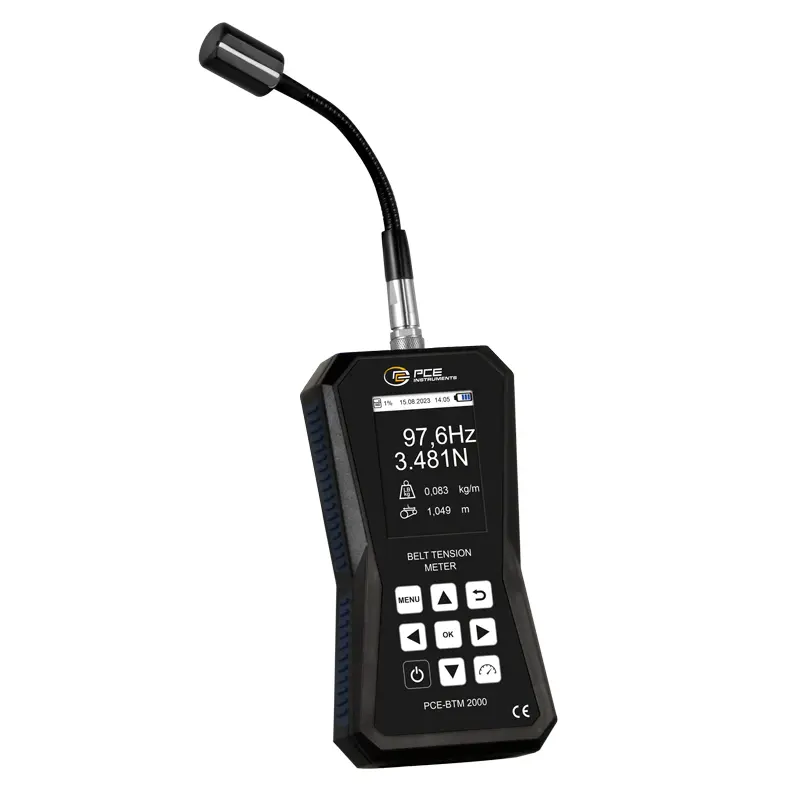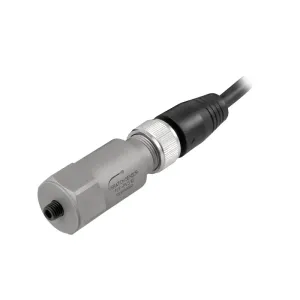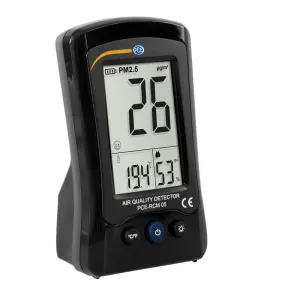Air Quality Meter
Indoor air quality meters are indispensable tools for confined spaces, ensuring mold prevention, monitoring CO2 levels, and detecting gas leaks. These devices come in various forms – portable, fixed, handheld, or wall-mounted – and are vital for upholding health and safety standards.
At Dhanbad Instruments, our range of air quality monitoring devices aligns with industry standards, promoting personal safety. They excel in detecting, measuring, and monitoring a wide spectrum of parameters, including relative humidity, ambient temperature, carbon dioxide (CO2), volatile organic compounds (VOCs), formaldehyde (HCHO), freon, phosphine (PH3), hydrogen sulfide (H2S), carbon monoxide (CO), nitrogen dioxide (NO2), oxygen (O2), ozone (O3), and other flammable, hazardous, or toxic gases.
Some air quality meter devices offer auto-calibration, simplifying gas detector calibration. Additionally, many models allow you to store measurement values and effortlessly transfer data to a computer for in-depth analysis. Indoor air quality meters are a critical asset in confined spaces, where their role in mold prevention, CO2 level monitoring, and gas leak detection is paramount. Dhanbad Instruments proudly presents a diverse selection of air quality monitoring devices, rigorously adhering to industry safety standards. Explore their capabilities in measuring and monitoring various parameters, and leverage advanced features like auto-calibration and data transfer for precise analysis.
Air Quality Meter PCE-RCM 05
- Measuring Range: ± 12.7 Mm / S
- Frequency Range: 3 … 1500 Hz
- Design: Vertical Connection
- Power Supply: 12 … 24 V DC In Current Loop
Highlight
- Measures the oscillation frequency of the belt
- Measuring range: 10 … 900 Hz
- Accuracy: ± (1% of rdg. + 4 digits)
- – Resolution: <100 Hz: 0.1 Hz
- >100 Hz: 1 Hz
- Memory for 750 measured values
Highlight
- Measuring range: ± 12.7 mm / s
- Frequency range: 3 … 1500 Hz
- Design: vertical connection
- Power supply: 12 … 24 V DC in current loop
The PCE-RCM 05 air quality meter is a reliable device for the ongoing measurement of particulate matter levels in the workplace. The device provides real-time readings of PM2.5 particulate matter, temperature, and humidity, all of which are clearly displayed on the device screen.
- Measuring range PM2.5: 0 … 500 μg / m³
- Measuring range temperature: -10 … 50°C / 14 … 122°F
- Measuring range humidity: 0 … 99% rh
- Pictograms indicate air quality
- Battery operation
- Micro USB for charging
Comprehensive Purchase Advice on Indoor Air Quality Meters
Introduction to Indoor Air Quality Meters
Indoor air quality is a critical aspect of our well-being, as we spend a significant portion of our lives inside buildings. Poor indoor air quality can have adverse effects on health, causing respiratory issues, allergies, and more. To ensure the air you breathe is safe and healthy, an indoor air quality meter is an essential tool. In this comprehensive purchase advice guide, we will explore the world of indoor air quality meters, their importance, and how to make an informed decision when buying one.
Understanding the Significance of Indoor Air Quality

Before delving into the specifics of air quality meters, it’s vital to understand why monitoring indoor air quality is crucial. Indoor air can be polluted by a variety of factors, including volatile organic compounds (VOCs), carbon dioxide (CO2), mold, pollen, dust, and other contaminants. Poor indoor air quality can lead to health problems, such as allergies, asthma, and respiratory issues, making it imperative to measure and improve the air you breathe.
The Role of Indoor Air Quality Meters
Indoor air quality meters, often referred to as IAQ meters, are designed to assess and monitor various air quality parameters within enclosed spaces. These meters provide real-time data and measurements, enabling you to identify potential issues, take corrective measures, and create a healthier indoor environment. Their key functions include measuring CO2 levels, humidity, temperature, VOCs, particulate matter, and more.
Choosing the Right Indoor Air Quality Meter
Type of IAQ Meter
When considering the purchase of an indoor air quality meter, the first decision to make is the type of meter that best suits your needs. Indoor air quality meters come in several categories, each tailored to measure specific parameters:
- CO2 Monitors: These meters primarily measure carbon dioxide levels, a key indicator of indoor air quality.
- VOC Monitors: Volatile organic compounds are a significant contributor to indoor air pollution. VOC monitors are specialized in detecting and quantifying these compounds.
- Particulate Matter (PM) Meters: These meters focus on airborne particles, including dust, pollen, and other particulates, providing insights into air cleanliness.
- Multi-Parameter Meters: For comprehensive indoor air quality assessments, multi-parameter meters are equipped to measure CO2, humidity, temperature, VOCs, and more.
Accuracy and Precision
The accuracy and precision of your chosen IAQ meter are paramount. To ensure reliable measurements, opt for a meter with high accuracy and a low margin of error. It’s essential to choose a meter that provides dependable data for informed decision-making.
Display and Data Logging
Consider the display and data logging capabilities of the indoor air quality meter. A clear and easy-to-read display is crucial for real-time monitoring, and data logging features allow you to save and analyze measurements over time. Look for a device that offers both these features for enhanced usability.
Portability and Size
The portability and size of the IAQ meter may also be a significant factor in your decision. Depending on your specific needs, you might require a handheld, portable device, or a fixed, wall-mounted one. Consider where and how you plan to use the meter to determine the appropriate size and portability.
Calibration and Maintenance
Calibration is essential to ensure the accuracy of your IAQ meter’s measurements. Some meters require regular calibration, while others are self-calibrating or offer auto-calibration features. Additionally, consider the ease of maintenance and calibration when making your purchase.
Key Features to Look for in an Indoor Air Quality Meter
Real-time Monitoring
An indoor air quality meter should provide real-time data, allowing you to instantly identify changes in air quality and take prompt actions.
User-Friendly Interface
Look for a meter with an intuitive and user-friendly interface. A simple, easy-to-navigate menu and clear display are essential for hassle-free operation.
Data Logging and Analysis
Data logging capabilities are invaluable for tracking air quality over time. The ability to download and analyze data on a computer is a beneficial feature.
Alarm Functionality
Some IAQ meters come with alarm functions that notify you when specific air quality parameters reach unhealthy levels, ensuring timely responses to potential issues.
Connectivity
Consider whether the meter offers connectivity options, such as Bluetooth or Wi-Fi, for seamless data transfer to other devices or cloud-based platforms.
Battery Life
Battery life is crucial, especially for portable meters. Opt for a device with long battery life to ensure uninterrupted monitoring.
Measurement Range
The meter’s measurement range should cover the relevant parameters at levels suitable for your specific environment.
Durable Build
Durability is essential, especially for portable meters. Look for a robust and reliable build that can withstand various indoor environments.
Using Indoor Air Quality Meters for Various Applications
Indoor air quality meters find applications in a wide range of settings:
Home Use
IAQ meters can help homeowners monitor and improve the air quality in their residences, reducing the risk of health issues associated with poor indoor air.
Workplaces
Employers can use IAQ meters to ensure a safe and healthy work environment, boosting employee well-being and productivity.
Laboratories
In research and testing environments, accurate air quality measurements are crucial to maintaining the integrity of experiments and ensuring the safety of researchers.
Schools
Educational institutions can use IAQ meters to safeguard the health of students and staff by ensuring optimal indoor air quality.
Healthcare Facilities
Hospitals and clinics benefit from IAQ meters to maintain air quality that supports patient recovery and reduces the risk of airborne infections.
Industrial Settings
Industries with potential air quality hazards, such as manufacturing and chemical processing, can use IAQ meters to protect workers and meet regulatory requirements.
Benefits of Monitoring Indoor Air Quality
Health and Well-being
Monitoring indoor air quality contributes to better health, reducing the risk of respiratory problems, allergies, and illnesses caused by poor air quality.
Productivity
In workplaces, better air quality can enhance employee productivity and reduce absenteeism.
Energy Efficiency
Efficient monitoring can help optimize heating, cooling, and ventilation systems, reducing energy consumption.
Compliance
Meeting indoor air quality standards is crucial for regulatory compliance in various industries.
Making an Informed Purchase Decision
When purchasing an indoor air quality meter, consider the following key steps to make an informed decision:
Identify Your Specific Needs
Determine the parameters you need to measure, the location where the meter will be used, and any specific requirements for your application.
Research and Compare Models
Explore different IAQ meter models, their features, and customer reviews to find the one that aligns with your needs.
Set a Budget
Establish a budget for your purchase, considering the features and capabilities that matter most to you.
Evaluate Calibration and Maintenance
Check if the meter requires regular calibration and assess how user-friendly the maintenance process is.
Read the Manual
Familiarize yourself with the user manual to understand how to operate and maintain the IAQ meter properly.
Seek Expert Advice
If you’re uncertain about your choice, don’t hesitate to consult with experts or professionals who can provide guidance.
In conclusion, indoor air quality meters are invaluable tools for maintaining a healthy and safe indoor environment. With a focus on parameters like CO2 levels, humidity, temperature, VOCs, and more, these meters provide real-time data to help you make informed decisions regarding air quality. Whether for home, workplace, laboratory, or industrial use, selecting the right IAQ meter is essential for your well-being and the well-being of those around you. By understanding the significance of indoor air quality, the role of IAQ meters, and the key features to look for, you can confidently make a purchase that ensures a healthier indoor environment for all.%5





